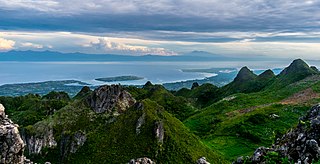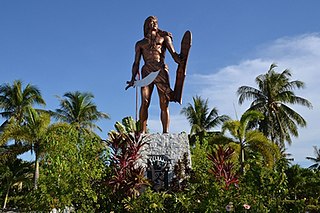
Cebu, officially the Province of Cebu, is a province of the Philippines located in the Central Visayas (Region VII) region, and consists of a main island and 167 surrounding islands and islets. The coastal zone of Cebu is identified as a site of highest marine biodiversity importance in the Coral Triangle.

Cebu City, officially the City of Cebu, is a 1st class highly urbanized city in the Central Visayas region of the Philippines. According to the 2020 census, it has a population of 964,169 people, making it the sixth-most populated city in the nation and the most populous in the Visayas and in Central Visayas Region.

Lapu-Lapu City, officially the City of Lapu-Lapu, is a 1st class highly urbanized city in the Central Visayas region of the Philippines. According to the 2020 census, it has a population of 497,604.

Mandaue, officially the City of Mandaue, is a 1st class highly urbanized city in the Central Visayas region of the Philippines. According to the 2020 census, it has a population of 364,116 people.

Mactan is a densely populated island located a few kilometers east of Cebu Island in the Philippines. The island is part of Cebu province and it is divided into the city of Lapu-Lapu and the municipality of Cordova.

Cordova, officially the Municipality of Cordova, is a 1st class municipality in the province of Cebu, Philippines. According to the 2020 census, it has a population of 70,595 people.

Marcelo Fernan Bridge, also known as Second Cebu–Mactan Bridge and the Second Bridge locally, is an extradosed cable-stayed bridge located in Metro Cebu in the Philippines. It crosses Mactan Channel connecting Mandaue in mainland Cebu to Lapu-Lapu City in Mactan Island. It is currently the second-longest cable-stayed bridge in the Philippines after Cebu–Cordova Link Expressway which also crosses the Mactan Channel. Before it was named the Marcelo Fernan Bridge, it was also called the Consolacion Bridge, owing to its proximity to the municipality of Consolacion, which is 1.6 miles (2.6 km) from the north end of the bridge. It is one of three bridges crossing Mactan Channel, the others being Mactan–Mandaue Bridge and the aforementioned Cebu–Cordova Link Expressway.

Metropolitan Cebu, or simply Metro Cebu,, is the main urban center of the province of Cebu in the Philippines. Metro Cebu is located along the central eastern portion of the island including the nearby island of Mactan. It accounts for 19.9 percent of the land area and 61.5 percent of the population of the entire province of Cebu.

Manila Water Company, Inc. has the exclusive right to provide water and used water (wastewater) services to over six million people in the East Zone of Metro Manila. It is a subsidiary of Enrique Razon's Trident Water Holdings Company, Inc., who acquired stakes from the country's oldest conglomerate, Ayala Corporation, in 2024.

Gwendolyn Fiel Garcia-Codilla is a Filipina politician serving as the governor of Cebu since 2019, a position she previously held from 2004 and 2013—being the first woman to hold that office. She was the representative of Cebu's 3rd congressional drict from 2013 to 2019 and concurrently served as a House Deputy Speaker from 2016 to 2018.

The Archdiocese of Cebu is a Latin Church archdiocese of the Catholic Church in the Philippines and one of the ecclesiastical provinces of the Catholic Church in the country. It is composed of the entire civil province of Cebu. The jurisdiction, Cebu, is considered as the fount of Christianity in the Far East.

The Mactan–Mandaue Bridge, officially known as Serging Veloso Osmeña Jr. Bridge, also known as the First Cebu–Mactan Bridge and First Bridge locally, is a truss bridge that crosses the Mactan Channel and connects the cities of Mandaue and Lapu-Lapu City in Metro Cebu, Philippines. It is one of three bridges that span across the Mactan Channel, the other being the Marcelo Fernan Bridge and the Cebu–Cordova Link Expressway, and connects the islands of Cebu and Mactan.

The Cebu Bus Rapid Transit System is a mass transit system under construction in Cebu City, Philippines. It is expected to become the first operational bus rapid transit project in the Philippines. Only one line has been planned in detail so far, but scheme developers note the potential to develop a larger network comprising the adjacent cities of Lapu-Lapu, Mandaue, and Talisay, all of which, together with Cebu City, form part of the Cebu metropolitan area.

The Mactan Channel, also known as Opon Channel, is a channel in Cebu, Philippines. It runs between mainland Cebu island and the smaller island of Mactan. The body of water is located within Metro Cebu, separating the localities of Mandaue and Cebu City in mainland Cebu and Lapu-Lapu City on Mactan. It is one of the three channels that connect the Cebu Strait to the Camotes Sea — the other two being the Hilutangan Channel and the Olango Channel.

The South Road Properties (SRP), also known as the South Reclamation Project, is a 300 ha reclamation area in Cebu City, Philippines. The area, which is reclaimed from Mactan Channel, is located off the coast of the southern district of Cebu City, near Barangays Mambaling, Inayawan, and Pasil. It spans from the shore of mainland Cebu to Kawit Point. An island-type reclaimed area, it is connected with mainland Cebu by the Cebu South Coastal Road and the Mambaling Access Road. Through the Cebu–Cordova Link Expressway, the SRP is also connected by land to Cordova and the island of Mactan.

The Cebu–Cordova Link Expressway (CCLEX), also known as the Cebu–Cordova Bridge and the Third Cebu–Mactan Bridge, is an 8.9-kilometer (5.5 mi) toll bridge expressway in Metro Cebu, Philippines. The bridge connects the South Road Properties in Cebu City in mainland Cebu, and Cordova, on Mactan island. Crossing the Mactan Channel, it is the third road link between Cebu and Mactan islands, and the first between Cebu City and Cordova. It is the longest sea-crossing bridge in the Philippines, surpassing the 2-kilometer (1.2 mi) San Juanico Bridge between Samar and Leyte, as well as Marcelo Fernan Bridge as the longest cable-stayed bridge in the Philippines. It also surpassed the 5-kilometer (3.1 mi) Candaba Viaduct of North Luzon Expressway (NLEX) connecting the provinces of Pampanga and Bulacan for being the longest bridge in the Philippines upon its completion on October 5, 2021.

Mactan–Cebu International Airport is an international airport serving Cebu and serves as the main gateway to the Central Visayas region in the Philippines. Located on a 797-hectare (1,970-acre) site in Lapu-Lapu City on Mactan, it is the second busiest airport in the Philippines. Opened on April 27, 1966, the airport serves as a hub for Philippine Airlines, and as an operating base for Cebu Pacific, Philippines AirAsia, and Sunlight Air.

Aboitiz Equity Ventures (AEV) is a Philippine holding company based in Metro Manila, with roots from Cebu City. The conglomerate operates in six major industries: Power, Banking and Financial Services, Food, Infrastructure, and Data Science and Artificial Intelligence. In 2017, the company was ranked 1793rd on the Forbes Global 2000. In 2022, AEV ventured into transforming its organization into a "Techglomerate" - a faster, stronger, and better version of a conglomerate. A techglomerate can refer to a startup tech company that has grown into a conglomerate or a legacy conglomerate that has used technology and startup culture to radically transform the way it behaves and operates. AEV is the latter of the two.

Mactan Shrine, also known as Liberty Shrine, is a memorial park on the island of Mactan in Lapu-Lapu City, Philippines. It hosts two monuments, namely the Magellan Monument, which is dedicated to Portuguese explorer Ferdinand Magellan and the Lapu Lapu Monument, a bronze statue which commemorates Lapu Lapu, a native leader who defeated Spanish soldiers led by Magellan in the 1521 Battle of Mactan.

Caubian Islands is a group of islands of Lapu-Lapu City, Philippines. Located in the Camotes Sea, it is approximately 13 kilometers (8.1 mi) north from Getafe, Bohol, and 15 kilometers (9.3 mi) east from Mactan Island. The group consists of two small islands: the bigger uninhabited Caubian Daku, also called Poo, and the smaller but densely populated Caubian Gamay. Both islands are located in the Danajon Bank, the only double barrier reef in the Philippines and known to be one of the richest fishing grounds in the country. It is part of the Olango Island Group. Most of the families depend on fishing and speak the Cebuano language. According to the 2020 census, the islands has a population of 2,429. With an area of around 0.06km2, Caubian Gamay has an estimated population density of 60,725/km2. It is regarded to be one of the densest populated islands in the world.




















